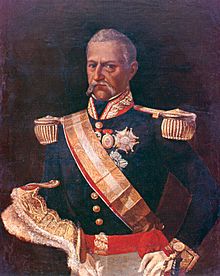You can help expand this article with text translated from the corresponding article in Spanish. (September 2014) Click [show] for important translation instructions.
|
Pedro José de Zavala y Bravo de Ribero, 7th Marquess of San Lorenzo del Valleumbroso, OIC, KOC (21 May 1779 – 20 January 1850),[1] was a Spanish-Peruvian nobleman and soldier.
The Marquis of Valleumbroso | |
|---|---|
 Portrait of the Marquis of Valleumbroso | |
| Personal details | |
| Born | Pedro José de Zavala y Bravo del Ribero 10 August 1779 Lima, Viceroyalty of Peru, Spain |
| Died | 20 June 1850 (aged 70) Lima, Peru |
| Spouse(s) | Grimanesa de la Puente y Bravo de Lagunas, Marquise of la Puente |
| Military service | |
| Allegiance | Spain |
| Branch/service | Spanish Army |
| Rank | Field marshall |
Biography
editZavala was born in Lima into one of the most prominent families of the Viceroyalty of Peru. He was the son of Pedro Nolasco de Zavala y Pardo de Figueroa, 6th Marquess of Valleumbroso, and Ana Micaela Bravo del Ribero y Zavala.
He joined the Army in 1787 as cadet of the 3rd Regiment of the Dragoons Guards of Lima. In 1790, Zavala was commissioned into the Cavalry Regiment of the Nobility as ensign and was transferred to the Company of Dragoons of Queen María Luisa in 1797. In 1799, he returned to the Dragoons Guards of Lima, where was promoted to captain in 1804.
In 1812, Zavala created the King's Cavalry Company and was promoted to the rank of lieutenant colonel in the Royal Army. In 1819, he was appointed colonel of the Battalion of Spaniards. During the War of Independence, he defended the Callao, Chancay and Ancón ports in 1820 and 1821. Zavala supported the Aznapuquio mutiny that deposed the Viceroy and was commissioned to inform the King of the situation by the new viceroy José de la Serna. However, his mission was abruptly delayed since the brigantine Maypú in which Zavala was transported was captured by an Argentinian frigate in June 1821.
He settled down in Madrid. Joined to the Infante Don Carlos Regiment and afterwards the Battalion of Guías, he was awarded the Grand Cross of the Order of Isabella the Catholic for his services in Peru in 1822 and was appointed Gentilhombre de cámara con ejercicio by Fernando VII in 1824. Zavala was successively promoted to brigadier in 1826 and to field marshal in 1836. Next year, he was appointed second lieutenant of the Guard of Halberdiers (the Queen's guard), which he commanded from 1841 to 1843.
Zavala returned to Peru, where he died the next year.
Marriage and issue
editHe married in 1804 Grimanesa de la Puente y Bravo, 4th Marchioness of Torreblanca, 5th Countess of Villaseñor and 2nd Marchioness of La Puente y Sotomayor, and had twelve children:
- Pedro de Zavala y la Puente, Peruvian soldier.
- Juan de Zavala, 1st Marquess of Sierra Bullones, Prime Minister of Spain.
- Toribio de Zavala y la Puente, Peruvian Army colonel.
- José de Zavala y la Puente, colonel prefect of Trujillo.
- Grimanesa de Zavala y la Puente, married to José Gregorio Paz Soldán.
- Andrés de Zavala y la Puente, stepfather of Manuel González Prada.
- Ana de Zavala y la Puente, 1st Marchioness of La Puente.
References
edit- ^ Castejón, Antonio. "Casa de Zabala". Gure Arbasoak (in Spanish).
Further reading
edit- Rizo Patrón, Paul (2000). Linaje, dote y poder: La nobleza de Lima de 1700 a 1850. Lima: PUCP.
- Tauro del Pino, Alberto (2001). Enciclopedia Ilustrada del Perú. Lima: PEISA.